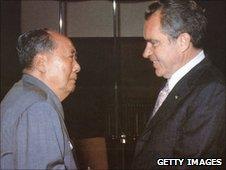China continue to lead the way
- Published
Table tennis is massive in China - it's historic, it's culturally significant, it holds a very special place in the hearts of most Chinese people.

China's Wang Hao is the current men's world number one
It was Chairman Mao Zedong, communist leader and founder of the People's Republic of China, who decided to make table tennis the national sport in the early 1950s.
'The Great Leader' wanted to boost the confidence of his people by making them successful in the sporting arena.
Mao declared that everyone should play the sport and, because he was all powerful, that's what people did.
After a while, the Chinese people became very affectionate towards the sport. It became part and parcel of the national identity and patriotism and they've pretty much dominated ever since.
Mao received a lot of encouragement from Englishman Ivor Montagu, the president of the International Table Tennis Federation at the time.
The ITTF was one of the few international sports organisations to recognise China rather than Taiwan, which broke away from mainland China following a civil war in 1949.
The sport helped a lot with China's domestic politics - Chairman Mao's government could claim that everything was fantastic because they were winning in table tennis.
In 1959, Rong Guotuan became China's first sporting world champion. The three subsequent world titles were also captured by China and so began their long distinguished ping-pong history.
The international community began to take notice of China because of their success in table tennis, and it helped to bolster the political legitimacy of the communist regime.

Table tennis led to President Richard Nixon visiting China in 1972
It was also important in cementing China-US relations at the time, since nicknamed "ping pong diplomacy", when Mao invited the US table tennis team to the country in 1971.
That was followed by a groundbreaking visit from US President Richard Nixon the next year, the first to China by an American leader.
The 1980s and early 90s was a key period in China's table tennis history as they faced a challenge to their supremacy from Sweden.
During the 80s, Swedish players reconstructed the Chinese way of playing - long, powerful forehands and backhands - by using the shakehand grip rather than the penholder grip, external, where the paddle is held between the thumb and forefinger.
China, though it took them a while, realised they had to start using this method as well and eventually they did, adapting Sweden's championship-winning technique to reclaim their crown as table tennis' elite in the 1990s.
The Swedes were brilliant for about six or seven years. They had a number of players who were just magnificent, led by Jan-Ove Waldner - the 1992 Olympic men's singles champion - who, I think, was probably the best ever and is still a real hero in China for his spell-binding performances.
Waldner was a pioneer. His innovation, which led his country to prevail in the sport, changed the landscape of table tennis.
When he retired in 2006, Swedish table tennis never really had the same edge.
Today, the Chinese players have got pretty much everything, speed, tecnique and power.
The new generation are really wonderful players. Wang Hao, Zhang Jike and Ma Lin are all ranked in the men's top five and the women's team fill places one to five in the world rankings, led by Li Xiaoxia.
Matthew Syed was talking to Olympic sports reporter Jessica Creighton
Watch live streaming of the ITTF World Championships, which run until 15 May, at www.ittf.com
Drinkhall assesses China dominance
- Published25 April 2011